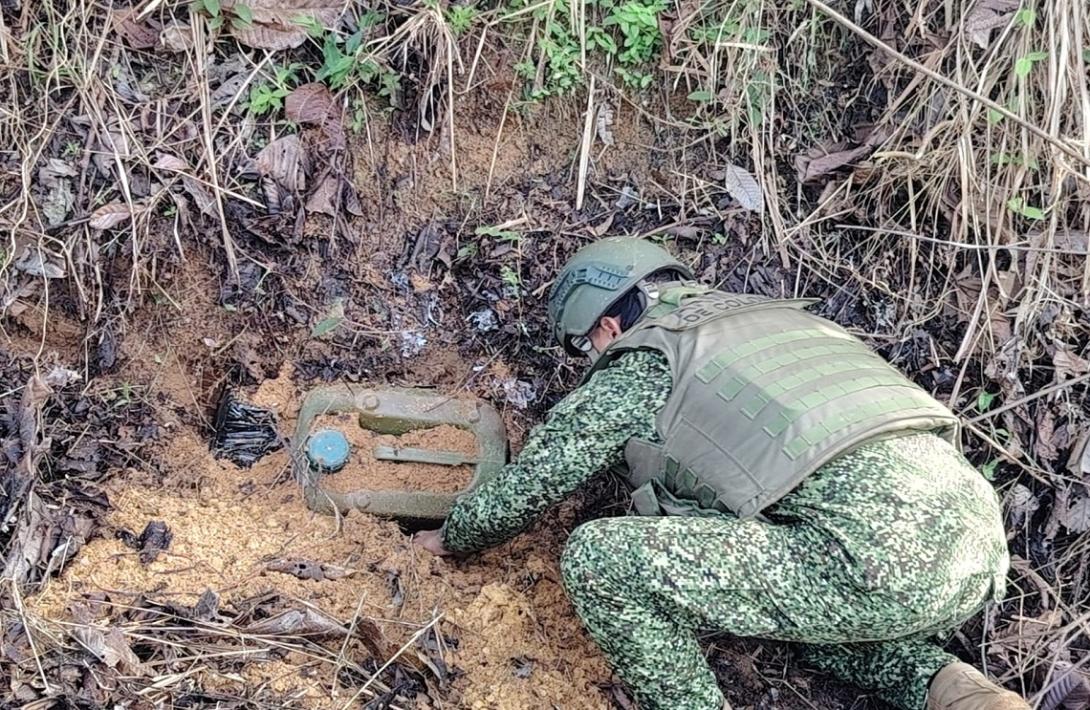Four illegal hiding places with explosives and an Improvised Explosive Devices ready to detonate were found by troops and destroyed in the departments of Putumayo, Meta and Caquetá.
The war material would belong to the Residual Organized Armed Groups frente Raúl Reyes and Jorge Suárez Briceño.
Within the framework of joint operations conducted by the Colombian Navy, Colombian National Army and the Colombian Aerospace Force, it was possible to find and destroy four illegal hiding places with more than a ton of explosives and an Improvised Explosive Device (IED) planted in the departments of Caquetá, Meta and Putumayo. These would be used to carry out terrorist operations against the inhabitants and the Military Forces in the south of the country, which could have caused irreparable damage to rural communities, with a high risk of severe beatings and loss of human lives.
The first operation was carried out in the Paraíso Mandur village of the municipality of Puerto Guzmán, Putumayo, by units of the Navy Infantry River Battalion No. 33 of the Navy, who found an illegal hiding place, finding 22 improvised munitions by 32 kilograms each, two 100-kilo cylinders equipped as launch pads, an additional 250 kilograms of rudimentary explosive, 20 non-electric detonators and 15 meters of security fuse, and the neutralization of approximately 954 kilograms of explosives, allegedly belonging to the Residual Organized Armed Group Raul Reyes Front.
In the second operation, troops of the River Infantry Battalion No. 30 of the Colombian Navy, found an illegal hiding place in the farm Los Hermilios, in the Alto Baranda sector, Putumayo department. Two handcrafted launching pads and 22 gas cylinders of about 10 kilos each were found by troops at the scene, apparently loaded with explosives.
The third finding occurred in the village of Caño La Torre, municipality of Puerto Rico, Meta, where units of the Navy Infantry River Battalion No. 32, found and destroyed an illegal hiding place with two rudimentary launching means similar to 65-millimeter mortars, five improvised munitions with characteristics similar to 60-millimeter grenades, five improvised explosive devices with a timed activation system and a backpack of military accessories, which allegedly belonged to the Marco Aurelio Buendía Structure of the Jorge Suárez Briceño block.
Finally, units of the Navy Infantry River Battalion No. 31, found an improvised explosive device planted in a rural area of the village of El Diamante, in the municipality of Cartagena del Chairá, Caquetá, which was ready to be used by members of the residual organized armed groups to attack the Military Forces and the inhabitants.
The explosives found were destroyed in controlled conditions at the places of the findings, by specialized personnel of the Explosives and Demining Groups of the Colombian Navy and Colombian National Army.
Through these results, the military forces prevented outlaw groups from putting the inhabitants at risk, with the use of explosives on rural roads, urban areas or even on aerial platforms such as drones, situations that put the most vulnerable communities in the region at serious risk.
Source: Press – Navy of Colombia

